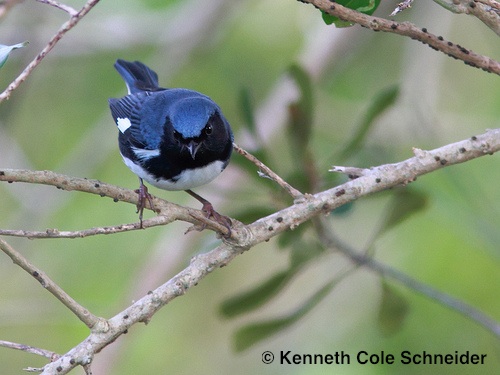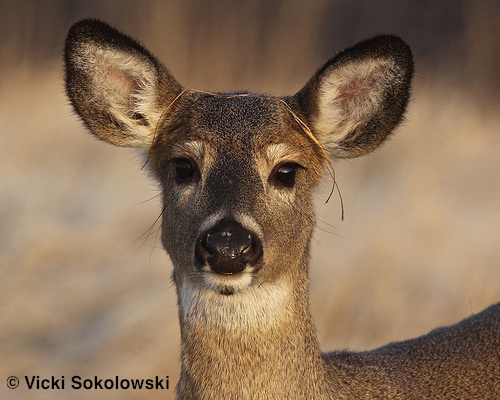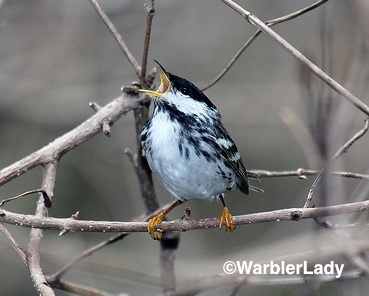After some calculations, I realize that I must go to my Mountain Bird Watch survey site this very night – there are no other options given the weather and my schedule. I don’t really want to pack my backpack or climb up a mountain today. Nor get up at the crack of dawn tomorrow to do the survey, but there appears to be no other choice.
My husband says, “Why do you continue volunteering for this if it’s such a bother?”
Frazzled by noisy neighbors I reply, “Because it is a balm for my soul.”
I hike up the mountainside in late evening. Three hermit thrushes cheer me along. I am out of shape, so I go slowly. I leave behind the noise of lawnmowers, misbehaving chainsaws, boisterous humans.
I arrive at the place I will camp and two black-throated blue warblers are countersinging, agreeing or disagreeing on the limits of their territories, or so we humans assume. One has a four- note song, the other sings five. The four-note singer is in plain sight, showing off his clean white chest and black throat. He is singing right above the place I will pitch the tent.
Perhaps if we could understand them we would be surprised. They might be discussing politics. Each phrase ends in an upward tone, as though they are asking a question. “Zhee zhee zhee…see?” Whatever the subject, they converse politely, asking each other questions.
Two white-throated sparrows are engaged in conversation. One’s song goes up a fourth. The other goes down a third. A third sparrow chimes in and he changes the tone of his last note, sliding it upwards like a singer afraid he has gone flat. White throated’s songs are sometimes described as sounding like, “Oh sweet Canada Canada Canada;” but there is so much variety within that pattern – up or down or the same tone, in thirds, fourths, or fifths, major and minor. I have even heard one singing a sixth tone. But I never heard a jazz performance before today.
During the evening I also hear a chucking- singing pattern that I suddenly realize is a Canada warbler. I go looking for his bright yellow chest in the green leaves, but he doesn’t appreciate my attentions, staying just out of sight and chipping unhappily. Go away, go away he says in his Canada-warbler tongue.
As I fall asleep the four-note black-throated blue continues his song until twilight. The Swainson’s thrushes – like other thrushes who are often the last birds to sing in the evening and the first to sing in the morning – sing awhile longer, then their songs devolve into call notes. Whhit, whhit they whisper comfortingly.
Then, utter silence. Not a leaf rustles. All the birds are tucked in for the night. I sleep too.
Just before dawn I awake to a thud. I wonder if it’s my food bag falling to the ground. Soon after I hear the unmistakable snort of a deer. It has been surprised by my tent in its trail. It huffs a long time as it retreats into the distance. This apparently awakes a Swainson’s thrush who begins calling and then, sings. The other birds ignore the summons for a little while, but then they too start to sing. The four-note black-throated blue is still right above the tent.
I must get up. I put on several layers, emerge from the tent, collect the food bag, walk to the first survey point. It is not yet full daylight and I need a flashlight to read the thermometer. I hear another thud. I stand up to look. A doe deer is staring at me through the leaves with wide startled eyes, ears pricked. After a frozen moment, she too retreats, huffing loudly. She sounds both frightened and indignant. “How could you surprise me like that,” her huffs seem to ask.
As I walk to the second survey point I hear a noise off to the left. In moments it develops into coyotes howling. Who knows what the howling means, but they sound happy. They are greeting the day together, as a pack, members of a community. Woo woo yip arrooo they tell one another, announcing their comradeship to the world.
At the third point I hear a Bicknell’s thrush. I may have heard the same bird last year in the same place, but not during the survey time, and so am gladdened that I have finally “caught” him as a datum. A statistic now, but one who lives, and breathes his sweet song into the cool morning air.
Two other Bicknell’s bless me with their presence, along with numerous winter wrens, Swainson’s thrushes, and white-throated sparrows. At one point I am trying desperately to see two Magnolia warblers – rhapsodies in black and yellow – while a Bicknell’s sings too. Which to look for? Two blackpoll warblers get into a chase and abandon their usual cryptic nature, flying about in the open. I am able to see them clearly – a rare occurrence.
The survey complete, I return to my tent. The four and five noted black-throated blues are still politely discussing property boundaries. The Canada warbler sings. Other bird species converse in their respective languages. I take my time packing up, enjoying their songs, the quietude.
As I hike back to civilization I have the unexpected pleasure of hearing both a mourning warbler and a wood peewee. A hermit thrush poses for me in plain sight on a dead branch.
Is there room for more in a heart already so full?




I can remember hearing the songs of the black-throated blue warbler, blackpoll warbler, and white-throated sparrow on the Long Trail many years ago. Thank you for the story. Brings back memories.